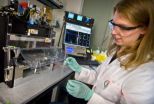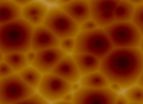(Press-News.org) An international team led by researchers with the Lawrence Berkeley National Laboratory (Berkeley Lab) has developed a new technique for identifying gene enhancers - sequences of DNA that act to amplify the expression of a specific gene – in the genomes of humans and other mammals. Called SIF-seq, for site-specific integration fluorescence-activated cell sorting followed by sequencing, this new technique complements existing genomic tools, such as ChIP-seq (chromatin immunoprecipitation followed by sequencing), and offers some additional benefits.
"While ChIP-seq is very powerful in that it can query an entire genome for characteristics associated with enhancer activity in a single experiment, it can fail to identify some enhancers and identify some sites as being enhancers when they really aren't," says Diane Dickel, a geneticist with Berkeley Lab's Genomics Division and member of the SIF-seq development team. "SIF-seq is currently capable of testing only hundreds to a few thousand sites for enhancer activity in a single experiment, but can determine enhancer activity more accurately than ChIP-seq and is therefore a very good validation assay for assessing ChIP-seq results."
Dickel is the lead author of a paper in Nature Methods describing this new technique. The paper is titled "Function-based identification of mammalian enhancers using site-specific integration." The corresponding authors are Axel Visel and Len Pennacchio, also geneticists with Berkeley Lab's Genomics Division. (See below for a complete list of authors.)
With the increasing awareness of the important role that gene enhancers play in normal cell development as well as in disease, there is strong scientific interest in identifying and characterizing these enhancers. This is a challenging task because an enhancer does not have to be located directly adjacent to the gene whose expression it regulates, but can instead be located hundreds of thousands of DNA base pairs away. The challenge is made even more difficult because the activity of many enhancers is restricted to specific tissues or cell types.
"For example, brain enhancers will not typically work in heart cells, which means that you must test your enhancer sequence in the correct cell type," Dickel says.
Currently, enhancers can be identified through chroma¬tin-based assays, such as ChIP-seq, which predict enhancer elements indirectly based on the enhancer's association with specific epigenomic marks, such as transcription factors or molecular tags on DNA-associated histone proteins. Visel, Pennacchio, Dickel and their colleagues developed SIF-seq in response to the need for a higher-throughput functional enhancer assay that can be used in a wide variety of cell types and devel-opmental contexts.
"We've shown that SIF-seq can be used to identify enhancers active in cardiomyocytes, neural progenitor cells, and embryonic stem cells, and we think that it has the potential to be expanded for use in a much wider variety of cell types," Dickel says. "This means that many more types of enhancers could potentially be tested in vitro in cell culture."
In SIF-seq, hundreds or thousands of DNA fragments to be tested for enhancer activity are coupled to a reporter gene and targeted into a single, reproducible site in embryonic cell genomes. Every embryonic cell will have exactly one potential enhancer-reporter. Fluorescence-activated sorting is then used to identify and retrieve from this mix only those cells that display strong reporter gene expression, which represent the cells with the most active enhancers.
"Unlike previous enhancer assays for mammals, SIF-seq includes the integration of putative enhancers into a single genomic locus," says co-corresponding author Visel. "Therefore, the activity of enhancers is assessed in a reproducible chromosomal context rather than from a transiently expressed plasmid. Furthermore, by making use of embryonic stem cells and in vitro differentia¬tion, SIF-seq can be used to assess enhancer activity in a wide variety of disease-relevant cell types."
Adds co-corresponding author Pennacchio, "The range of biologically or disease-relevant enhancers that SIF-seq can be used to identify is limited only by currently available stem cell differentiation methods. Although we did not explicitly test the activity of species-specific enhancers, such as those derived from certain classes of repetitive elements, our results strongly suggest that SIF-seq can be used to identify enhancers from other mammalian genomes where desired cell types are difficult or impossible to obtain."
The ability of SIF-seq to use reporter assays in mouse embryonic stem cells to identify human embryonic stem cell enhancers that are not present in the mouse genome opens the door to intriguing research possibilities as Dickel explains.
"Human and chimpanzee genes differ very little, so one hypothesis in evolutionary genomics holds that humans and chimpanzees are so phenotypically different because of differences in the way they regulate gene expression. It is very difficult to carry out enhancer identification through ChIP-seq that would be useful in studying this hypothesis," she says. "However, because SIF-seq only requires DNA sequence from a mammal and can be used in a variety of cell types, it should be possible to compare the neuronal enhancers present in a large genomic region from human to the neuronal enhancers present in the orthologous chimpanzee region. This could potentially tell us interesting things about the genetic differences that differentiate human brain development from that of other primates."
INFORMATION:
In addition to Dickel, Pennacchio and Visel, other co-authors of the Nature Methods paper were Yiwen Zhu, Alex Nord, John Wylie, Jennifer Akiyama, Veena Afzal, Ingrid Plajzer-Frick, Aileen Kirkpatrick, Berthold Göttgens and Benoit Bruneau.
This research was primarily supported by the National Institutes of Health.
Lawrence Berkeley National Laboratory addresses the world's most urgent scientific challenges by advancing sustainable energy, protecting human health, creating new materials, and revealing the origin and fate of the universe. Founded in 1931, Berkeley Lab's scientific expertise has been recognized with 13 Nobel prizes. The University of California manages Berkeley Lab for the U.S. Department of Energy's Office of Science. For more, visit http://www.lbl.gov.
New technique for identifying gene-enhancers
Berkeley Lab-led research team unveils powerful new tool for studying DNA elements that regulate genes
2014-03-24
ELSE PRESS RELEASES FROM THIS DATE:
Smokers' bitter taste buds may be on the fritz
2014-03-24
Smokers and those who have quit cannot fully appreciate the full flavor of a cup of coffee, because many cannot taste the bitterness of their regular caffeine kick. This is the finding of a study led by Nelly Jacob of the Pitié-Salpêtrière Hospital APHP in France, published in Springer's journal Chemosensory Perception.
It is already known that smoking, and especially the toxic chemicals in tobacco, causes a loss of taste among smokers. It also causes structural changes to the fungiform papillae of the tongue where the taste buds are located. However, it is not yet known ...
A mathematical equation that explains the behavior of nanofoams
2014-03-24
This news release is available in Spanish.
A research study, participated in by Universidad Carlos III de Madrid (UC3M), has discovered that nanometric-size foam structures follow the same universal laws as does soap lather: small bubbles disappear in favor of the larger ones.
The scientific team, made up of researchers from the Consejo Superior de Investigaciones Científicas (Spanish National Research Council) - CSIC, the Universidad Pontificia Comillas de Madrid- UPCO, and UC3M, reached this conclusion after producing and characterizing nanofoam formed by ion ...
Plugging the hole in Hawking's black hole theory
2014-03-24
EAST LANSING, Mich. --- Recently physicists have been poking holes again in Stephen Hawking's black hole theory – including Hawking himself. For decades physicists across the globe have been trying to figure out the mysteries of black holes – those fascinating monstrous entities that have such intense gravitational pull that nothing – not even light – can escape from them. Now Professor Chris Adami, Michigan State University, has jumped into the fray.
The debate about the behavior of black holes, which has been ongoing since 1975, was reignited when Hawking posted a ...
Patient enrollment, use, and satisfaction with patient portals
2014-03-24
Many physicians are adopting patient portals in response to governmental incentives for meaningful use (MU), but the stage 2 requirements for portal use may be particularly challenging for newer electronic health record (EHR) users. This study examines enrollment, use based on MU requirements, and satisfaction in a recently-adopting fee-for-service multispecialty system. The Centers for Medicare and Medicaid Services (CMS) financial incentives for meaningful use (MU)1 likely will persuade many reluctant doctors to adopt electronic health records (EHRs). However, there are ...
Research finds moving public assistance payments from cash to plastic cuts crime
2014-03-24
ATLANTA--Counties that change their delivery of public assistance benefits from paper checks to an Electronic Benefit Transfer (EBT) system – using debit cards – see their street crimes drop significantly, according to a study published today by the National Bureau of Economic Research.
Titled "Less Cash, Less Crime: Evidence from the Electronic Benefit Transfer Program," the study is the first to empirically examine whether the introduction of an EBT system, which reduces the amount of cash circulated on the streets, will disrupt criminal activities that rely on the ...
First look at breast microbiota raises tantalizing questions
2014-03-24
The female breast contains a unique population of microbes relative to the rest of the body, according to the first-ever study of the breast microbiome. That study sought to lay the groundwork for understanding how this bacterial community contributes to health and disease, says first author Camilla Urbaniak, a PhD student at the University of Western Ontario. The research was published ahead of print in Applied and Environmental Microbiology.
"Proteobacteria was the dominant phylum in healthy breast tissue," says Urbaniak, noting that it is found only in small proportions ...
Prostate treatment lasts, preserves fertility
2014-03-24
SAN DIEGO (March 24, 2014)—Shrinking the prostate without surgery can provide long-term relief to men with this common condition that causes annoying symptoms, such as frequent trips to the bathroom, suggests a study of nearly 500 men. According to research being presented at the Society of Interventional Radiology's 39th Annual Scientific Meeting, 72 percent of men experienced symptom improvement three years after having a new, minimally invasive, image-guided treatment performed by interventional radiologists called prostate artery embolization (PAE).
"The results of ...
New implant shows promise for painful osteoporotic spine fractures
2014-03-24
SAN DIEGO (March 24, 2014)—Individuals suffering from spinal fractures—caused by osteoporosis or weakened bones—now have another option to reduce pain, restore function and improve quality of life, according to a study of 300 patients treated with a new type of vertebral augmentation. Results of a randomized, controlled multicenter trial on a new implant treatment for vertebral compression fractures are being reported for the first time at the Society of Interventional Radiology's 39th Annual Scientific Meeting.
Made of medical polymer, the implant is designed to treat ...
Keep calm and don your video glasses
2014-03-24
SAN DIEGO (March 24, 2014)—Music may soothe the soul, but it takes video to calm a patient undergoing medical treatment, notes a study in which individuals watched television shows or movies through special video glasses while having a biopsy or other minimally invasive treatment. The research is being presented at the Society of Interventional Radiology's 39th Annual Scientific Meeting.
Although interventional radiology treatments offer less risk, less pain and less recovery time compared to open surgery, patients nonetheless may be anxious about them and their outcomes. ...
Y-90 provides new, safe treatment for metastatic breast cancer
2014-03-24
SAN DIEGO (March 24, 2014)—A minimally invasive treatment that delivers cancer-killing radiation directly to tumors shows promise in treating breast cancer that has spread to the liver when no other treatment options remain, according to research being presented at the Society of Interventional Radiology's 39th Annual Scientific Meeting. In the largest study of its kind to date, researchers reviewed treatment outcomes of 75 women (ages 26-82) with chemotherapy-resistant breast cancer liver metastases, which were too large or too numerous to treat with other therapies. The ...
LAST 30 PRESS RELEASES:
Fish freshness easily monitored with a new sensor
Antibiotics could trigger immune response through gut microbiome metabolites
New Family Heart Foundation study finds only 13% of adults with cardiovascular disease achieve comprehensive LDL-C management
UT San Antonio physicists' groundbreaking discoveries open new paths to combating diseases
Operando X-ray tomography reveals silicon–electrolyte interface dynamics in all-solid-state batteries
Building better, building beautiful
Okayama University chemists pioneer light-driven macrolactone synthesis
Understanding how plants distribute iron to young leaves
Next-generation neuro: Studying the infant brain in motion
Before the party starts: Parental attitudes linked to college binge drinking
Ultrasound pinpoints vascular complications from cosmetic fillers
Human gene maps are biased towards European ancestries
Atomically-tailored single atom platforms hold promise for next-generation catalysis
USC study reveals hidden cellular layers in the brain’s memory center
SPHERE’s debris disk gallery: tell-tale signs of dust and small bodies in distant solar systems
Terrestrial biodiversity grows with tree cover in agricultural landscapes
Experts call for AED placement on every commercial aircraft to boost in-flight cardiac arrest survival rates from 6% to up to 70%
“Proton‑iodine” regulation of protonated polyaniline catalyst for high‑performance electrolytic Zn‑I2 batteries
Directional three‑dimensional macroporous carbon foams decorated with WC1−x nanoparticles derived from salting‑out protein assemblies for highly effective electromagnetic absorption
Tropical Australian study sets new standard for Indigenous-led research
Invitation to co-edit a special issue on intelligent additive manufacturing
Success in measuring nano droplets, a new breakthrough in hydrogen, semiconductor, and battery research
Shopping for two is stressful
Micro/nano‑reconfigurable robots for intelligent carbon management in confined‑space life‑support systems
Long-term antidepressant use surges in Australia, sparking warnings of overprescribing
To bop or to sway? The music will tell you
Neural network helps detect gunshots from illegal rainforest poaching
New evidence questions the benefit of calcium supplements in pregnancy for preventing pre-eclampsia
A molecular ‘reset button’ for reading the brain through a blood test
Why do some lung transplant patients face higher rejection risk?
[Press-News.org] New technique for identifying gene-enhancersBerkeley Lab-led research team unveils powerful new tool for studying DNA elements that regulate genes



